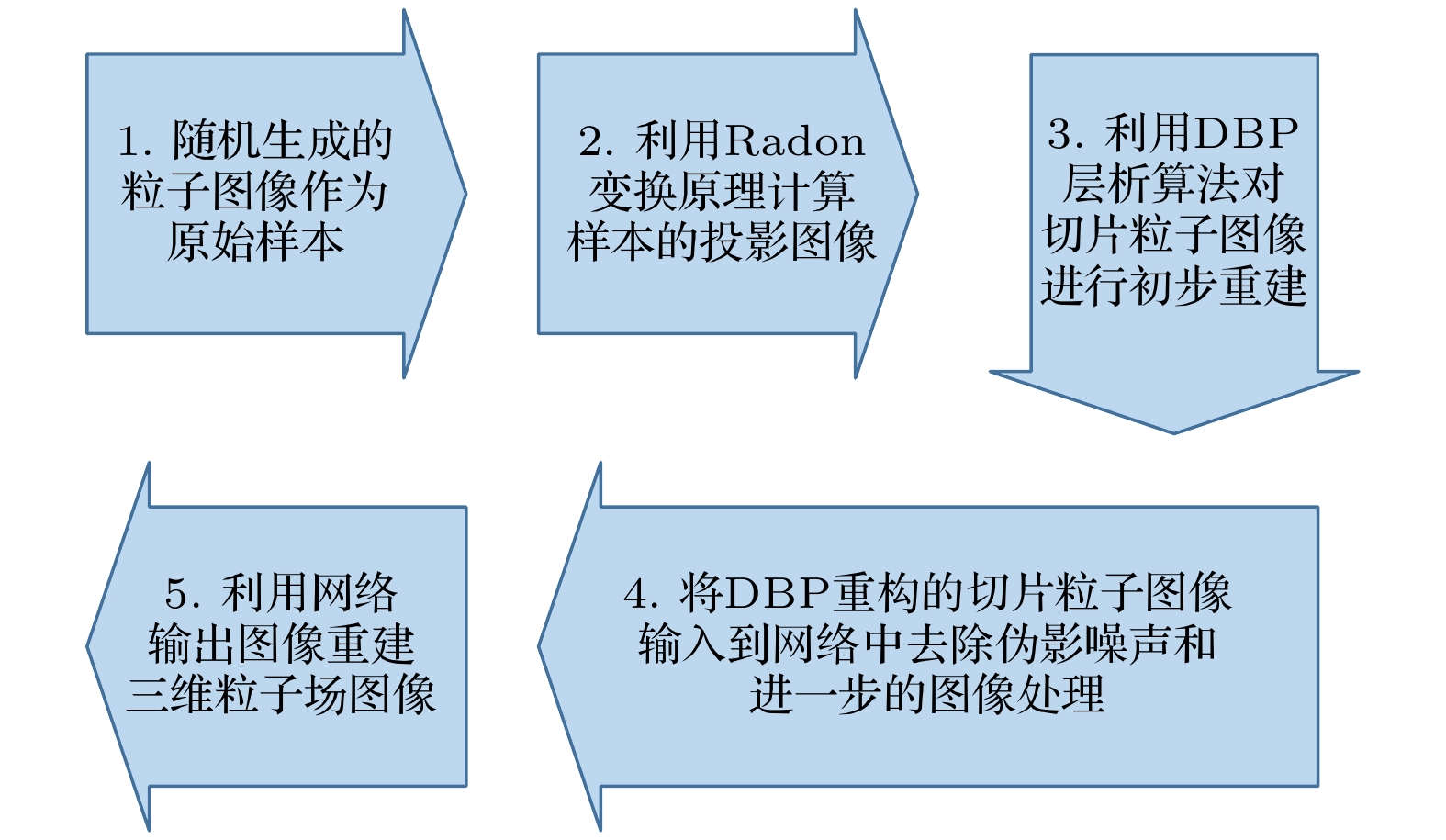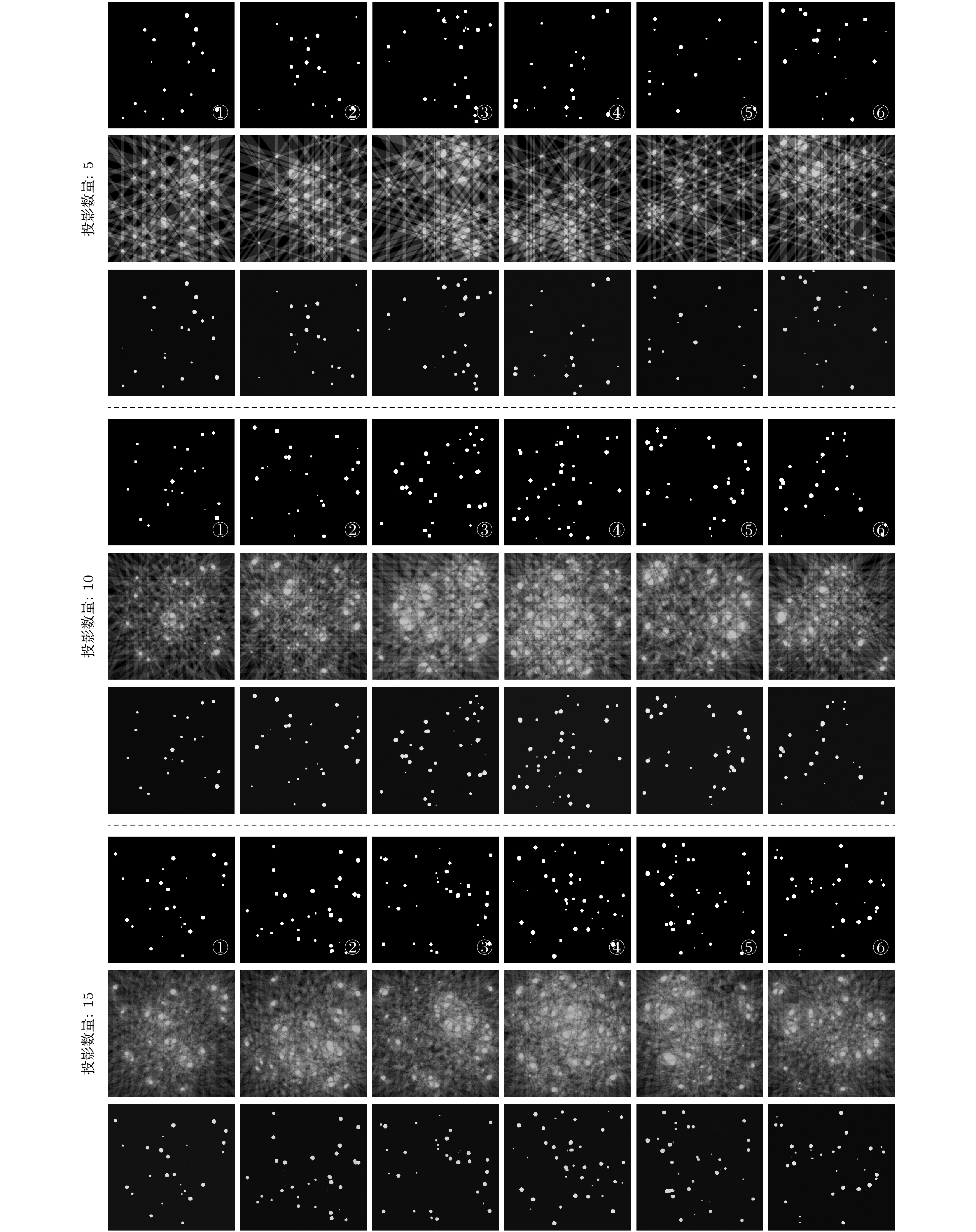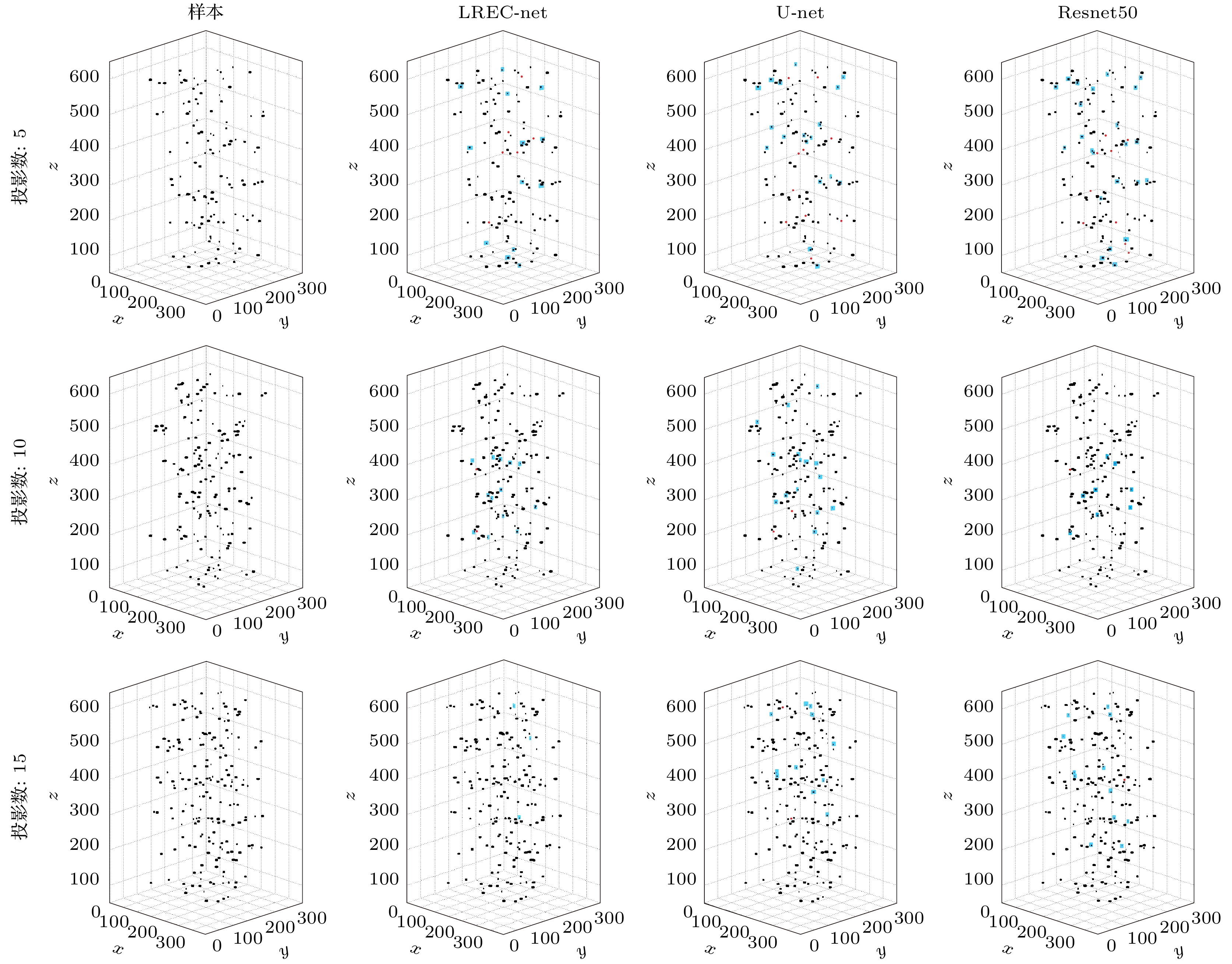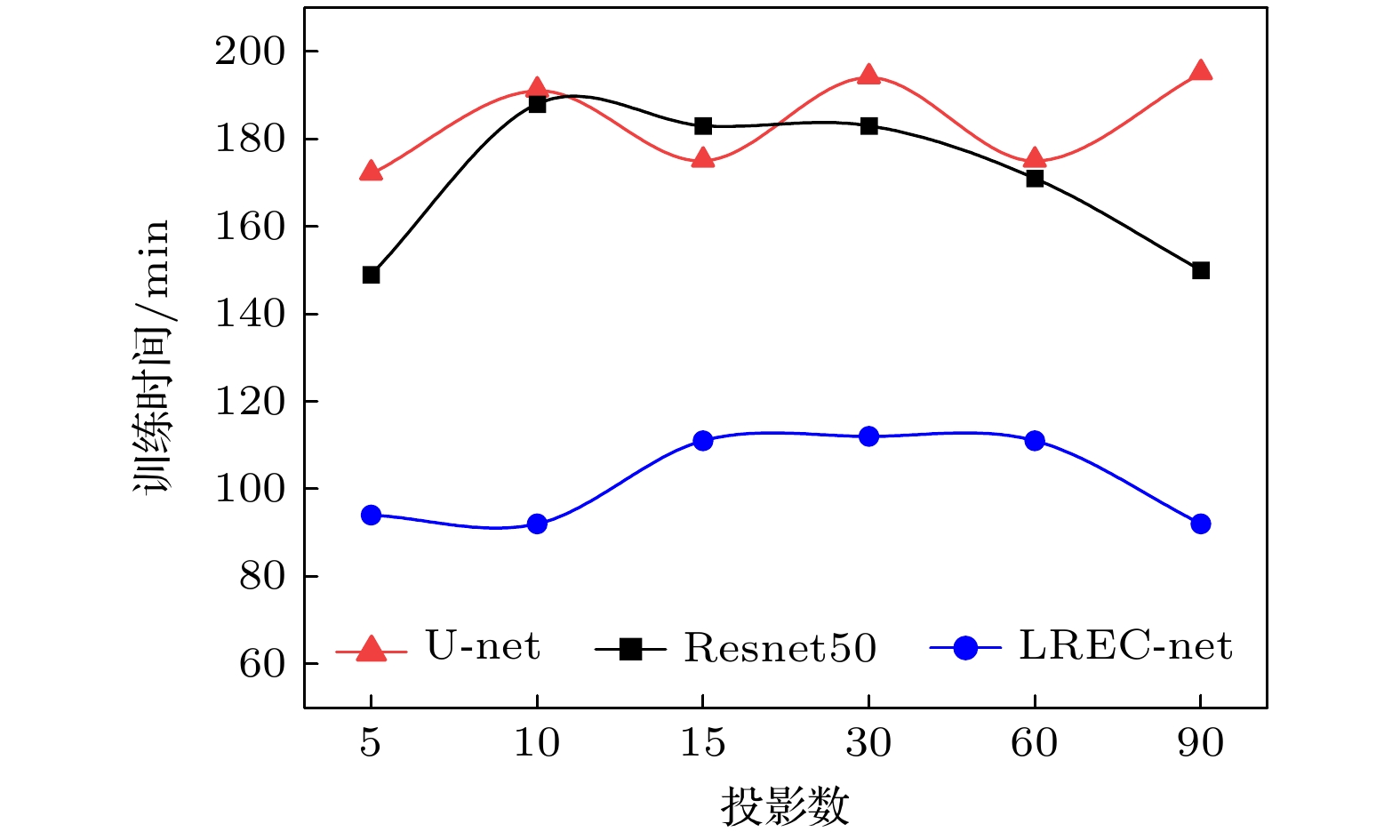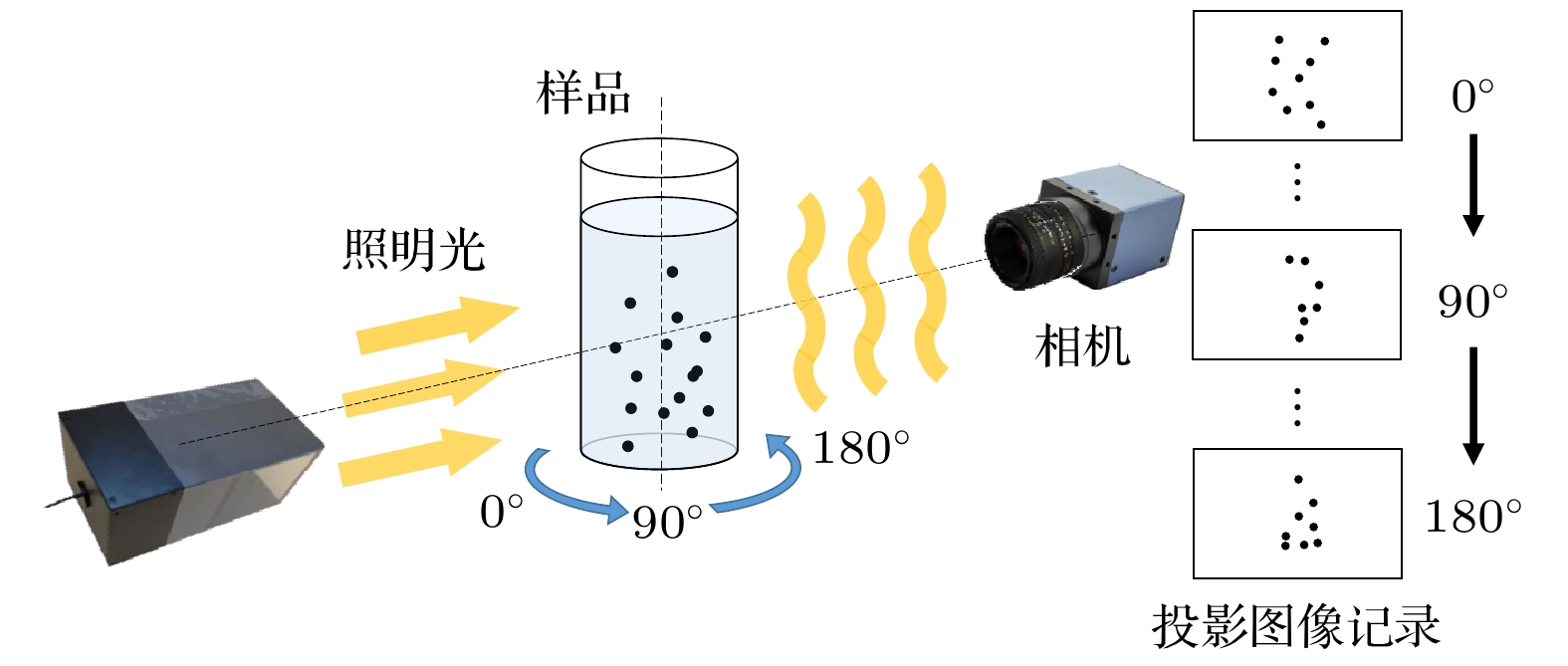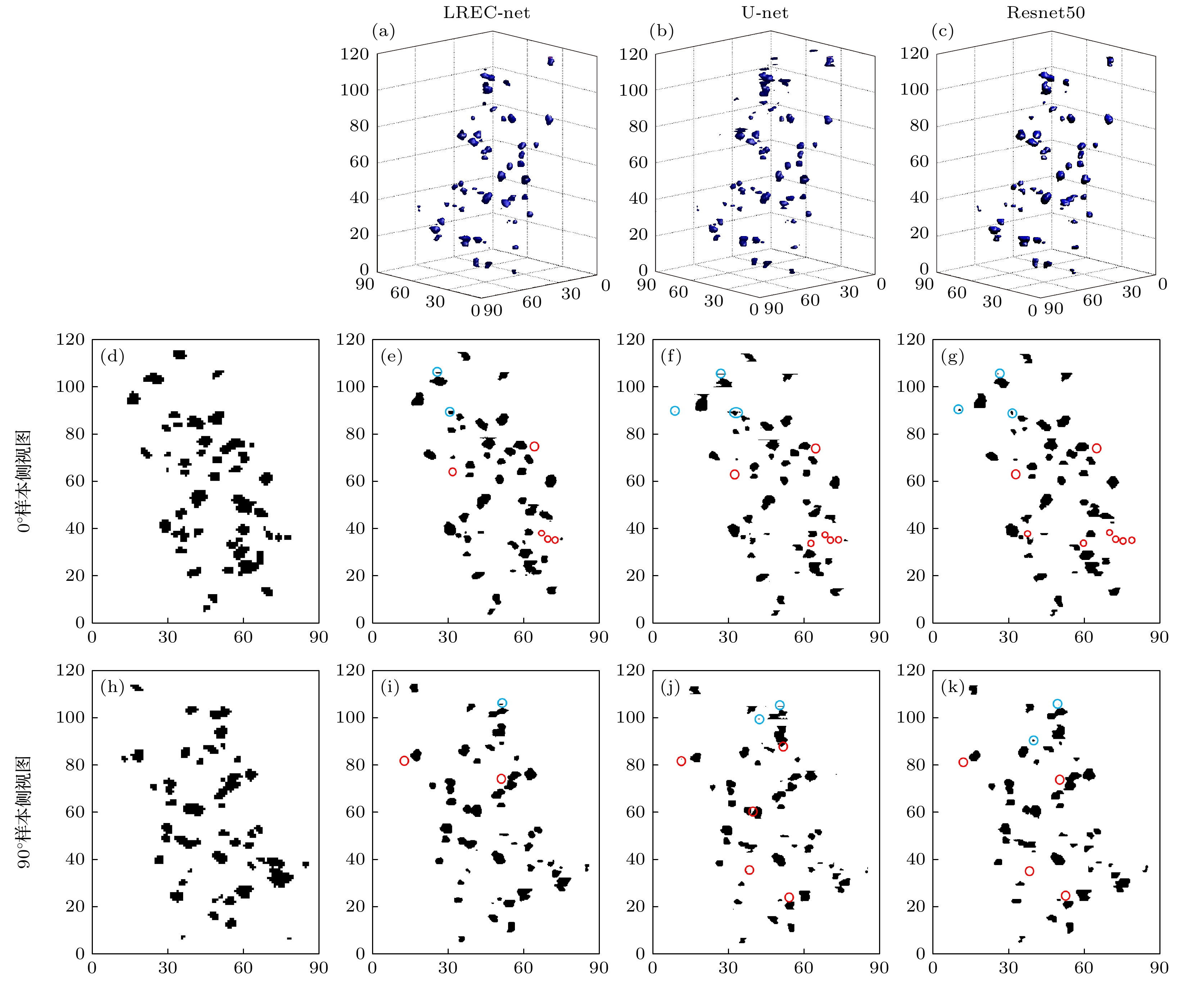-
由于流场中的微粒分布状态能够充分表征场的特性, 因此通过稀疏采样实现快速和高质量的粒子场成像始终是实验流体力学等领域高度期盼的. 近年来, 随着深度学习应用于粒子计算层析成像, 如何提高神经网络的处理效率和质量, 以消除稀疏采样所致的粒子层析图像伪影噪声仍然是一个挑战性课题. 为解决这一问题, 本文提出了一种新的抑制粒子场层析成像伪影噪声和提高网络效率的神经网络方法. 该方法在设计上包含了轻量化双残差下采样图像压缩和特征识别提取、快速特征收敛的上采样图像恢复, 以及基于经典计算层析成像算法的优化信噪比网络输入样本集构建. 对整个成像系统的模拟分析和实验测试表明, 相比于经典的U-net和Resnet50网络方法, 本文提出的方法不仅在输出/输入的粒子图像信噪比、重建像的残余伪影噪声(即鬼粒子占比)和有效粒子损失比方面获得了极大的改进, 而且也显著提高了网络的训练效率. 这对发展基于稀疏采样的快速和高质量粒子场计算层析成像提供了一个新的有效方法.
The realization of fast and high-quality three-dimensional particle-field image characterization is always highly desired in the areas, such as experimental fluid mechanics and biomedicine, for the micro-particle distribution status in a flow-field can characterize the field properties well. In the particle-field image reconstruction and characterization, a wildly used approach at present is the computed tomography. The great advantage of the computed tomography for particle-field image reconstruction lies in the fact that the full particle spatial distribution can be obtained and presented due to multi-angle sampling. Recently, with the development and application of deep learning technique in computed tomography, the image quality has been greatly improved by the powerful learning ability of a deep learning network. In addition, the deep learning application also makes it possible to speed up the computed tomographic imaging process from sparse-sampling due to the ability of the network to strongly extract image feature. However, sparse-sampling will lead to insufficient acquirement of the object information during sampling for the computed tomography. Therefore, a sort of artifact noise will emerge and be accompanied with the reconstructed images, and thus severely affecting the image quality. As there is no universal network approach that can be applied to all types of objects in the suppression of artifact noise, it is still a challenge in removing the sparse-sampling-induced artifact noise in the computed tomography now. Therefore, we propose and develop a specific lightweight residual and enhanced convergence neural network (LREC-net) approach for suppressing the artifact noise in the particle-field computed tomography. In this method, the network input dataset is also optimized in signal-to-noise ratio (SNR) in order to reduce the input noise and ensure the effective particle image feature extraction of the network in the imaging process. In the design of LREC-net architecture, a five-layer lightweight and dual-residual down-sampling is constructed on the basis of typical U-net and Resnet50, making the LREC-net more suitable for the particle-field image reconstruction. Moreover, a fast feature convergence module for rapid particle-field feature acquirement is added to up-sampling process of the network to further promote the network processing efficiency. Apart from the design of LREC-net network itself, the optimization of network input dataset in SNR of images is achieved by finding a fit image reconstruction algorithm that can produce higher-SNR particle images in the computed tomography. This achievement reduces the input noise as much as possible and ensures effective particle-field feature extraction by the network. The simulation analysis and experimental test demonstrate the effectiveness of the proposed LREC-net method, which involves the evaluations of SNR changes of the input-output images through the network, the proportion of residual artifact noise as ghost-particles (GPP) in the reconstructed images, and the valid-particle loss proportion (PLP). In contrast to the performances of U-net and Resnet50 under the same imaging conditions, all the data in SNR, GPP and PLP show the great improvement of the image quality due to the application of LREC-net method. Meanwhile, the designed LREC-net method also enhances the network running efficiency to a large extent due to the remarkable reduction of training time. Therefore, this work provides a new and effective approach for developing sparse-sampling-based fast and high-quality particle-field computed tomography. -
Keywords:
- particle field imaging /
- computed tomography /
- deep learning /
- noise suppression
[1] Yang L, Qiu Z, Alan H, Lu W 2012 IEEE T. Bio-Med. Eng. 59 7
 Google Scholar
Google Scholar
[2] Nayak A R, Malkiel E, McFarland M N, Twardowski M S, Sullivan J M 2021 Front. Mar. Sci. 7 572147
 Google Scholar
Google Scholar
[3] Healy S, Bakuzis A F, Goodwill P W, Attaluri A, Bulte J M, Ivkov R 2022 Wires. Nanomed. Nanobi. 14 e1779
 Google Scholar
Google Scholar
[4] Gao Q, Wang H P, Shen G X 2013 Chin. Sci. Bull. 58 4541
 Google Scholar
Google Scholar
[5] Oudheusden B W V 2013 Meas. Sci. Technol. 24 032001
 Google Scholar
Google Scholar
[6] Sun Z K, Yang L J, Wu H, Wu X 2020 J. Environ. Sci. 89 113
 Google Scholar
Google Scholar
[7] Arhatari B D, Riessen G V, Peele A 2012 Opt. Express 20 21
 Google Scholar
Google Scholar
[8] Vainiger A, Schechner Y Y, Treibitz T, Avin A, Timor D S 2019 Opt. Express 27 12
 Google Scholar
Google Scholar
[9] Cernuschi F, Rothleitner C, Clausen S, Neuschaefer-Rube U, Illemann J, Lorenzoni L, Guardamagna C, Larsen H E 2017 Powder Technol. 318 95
 Google Scholar
Google Scholar
[10] Wang H P, Gao Q, Wei R J, Wang J J 2016 Exp. Fluids 57 87
 Google Scholar
Google Scholar
[11] Kahnt M, Beche J, Brückner D, Fam Y, Sheppard T, Weissenberger T, Wittwer F, Grunwaldt J, Schwieger W, Schroer C G 2019 Optica 6 10
 Google Scholar
Google Scholar
[12] Zhou X, Dai N, Cheng X S, Thompson A, Leach R 2022 Powder Technol. 397 117018
 Google Scholar
Google Scholar
[13] Lell M M, Kachelrieß M 2020 Invest. Radiol. 55 1
 Google Scholar
Google Scholar
[14] Chen H, Zhang Y, Zhang W H, Liao P X, Li K, Zhou J L, Wang G 2017 Biomed. Opt. Express 8 679
 Google Scholar
Google Scholar
[15] Qian K, Wang Y, Shi Y, Zhu X X 2022 IEEE Trans. Geosci. Remote Sens. 60 4706116
 Google Scholar
Google Scholar
[16] Wei C, Schwarm K K, Pineda D I, Spearrin R 2021 Opt. Express 29 14
 Google Scholar
Google Scholar
[17] Zhang Z C, Liang X K, Dong X, Xie Y Q, Cao G H 2018 IEEE T. Med. Imaging 37 1407
 Google Scholar
Google Scholar
[18] Jin K H, McCann M T, Froustey E, Unser M 2017 IEEE T. Image Process. 26 9
 Google Scholar
Google Scholar
[19] Han Y, Ye J C 2018 IEEE T. Med. Imaging 37 1418
 Google Scholar
Google Scholar
[20] Gao Q, Pan S W, Wang H P, Wei R J, Wang J J 2021 AIA 3 1
 Google Scholar
Google Scholar
[21] Wu D F, Kim K, Fakhri G EI, Li Q Z 2017 IEEE T. Med. Imaging 36 2479
 Google Scholar
Google Scholar
[22] Liang J, Cai S, Xu C, Chu J 2020 IET Cyber-Syst Robot 2 1
 Google Scholar
Google Scholar
[23] Wu W W, Hu D L, Niu C, Yu H Y, Vardhanabhuti V, Wang G 2021 IEEE T. Med. Imaging 40 3002
 Google Scholar
Google Scholar
[24] Xia W, Yang Z, Zhou Q, Lu Z, Wang Z, Zhang Y 2022 Medical Image Computing and Computer Assisted Intervention 13436 790
 Google Scholar
Google Scholar
[25] Zhang C, Li Y, Chen G 2021 Med. Phys. 48 10
 Google Scholar
Google Scholar
[26] Cheslerean-Boghiu T, Hofmann F C, Schultheiß M, Pfeiffer F, Pfeiffer D, Lasser T 2023 IEEE T. Comput. Imag. 9 120
 Google Scholar
Google Scholar
[27] Gmitro A F, Tresp V, Gindi G R 1990 IEEE T. Med. Imaging 9 4
 Google Scholar
Google Scholar
[28] Horn B K P 1979 Proc. IEEE 67 12
 Google Scholar
Google Scholar
[29] Chen G H 2003 Med. Phys. 30 6
 Google Scholar
Google Scholar
[30] Chen G H, Tokalkanahalli R, Zhuang T, Nett B E, Hsieh J 2006 Med. Phys. 33 2
 Google Scholar
Google Scholar
[31] Feldkamp L A, Davis L C, Kress J W 1984 J. Opt. Soc. Am. A 1 6
 Google Scholar
Google Scholar
[32] Yang H K, Liang K C, Kang K J, Xing Y X 2019 Nucl. Sci. Tech. 30 59
 Google Scholar
Google Scholar
[33] Katsevich A 2002 Phys. Med. Biol. 47 15
 Google Scholar
Google Scholar
[34] Zeng G L 2010 Medical Image Reconstruction: A Conceptual Tutorial (Berlin: Springer) pp10–28
[35] Lechuga L, Weidlich G A 2016 Cureus 8 9
 Google Scholar
Google Scholar
[36] Schmidt-Hieber J 2020 Ann. Statist. 48 4
 Google Scholar
Google Scholar
[37] Ioffe S, Szegedy C 2015 32nd International Conference on Machine Learning Lile, France, July 07—09, 2015 p448
[38] Ronneberger O, Fischer P, Brox T 2015 Medical Image Computing and Computer-Assisted Intervention Springer, Cham, 2015 p234
[39] He K, Zhang X, Ren S, Sun J 2016 IEEE Conference on Computer Vision and Pattern Recognition Las Vegas, USA, 2016 p770
[40] Ramachandran G N, Lakshminarayanan A V 1971 PNAS 68 9
 Google Scholar
Google Scholar
[41] Kingma D P, Ba J L 2015 arXiv: 1412. 6980 [cs.LG]
[42] Bougourzi F, Dornaika F, Taleb-Ahmed A 2022 Knowl-Based Syst. 242 108246
 Google Scholar
Google Scholar
-
图 1 LREC-net网络架构图. Conv表示卷积; ReLU是整流线性单元, 用以提高模型的泛化能力并降低网络的计算成本[36]; BN是批量归一化处理, 可用于加速网络训练[37]
Fig. 1. Diagram of LREC-net architecture. Conv denotes convolution; ReLU is the rectified linear unit, which is used to promote the generalization ability of the model and reduce the computational cost of the network[36]; BN is the batch normalization, which can be used for accelerating network training[37].
图 5 随机生成3组粒子场模拟切片图像(编号为①—⑥)作为原始样本(各组第1行), DBP层析重建得到的LREC-net输入图像(各组第2行), 以及最终LREC-net输出图像(各组第3行), 每组层析图像重建的样本投影数分别为5, 10和15, 每个原始样本随机包含0—40个粒子, 这些粒子具有1—9个像素的不同大小
Fig. 5. Randomly-generated three groups of particle-field simulation slice images (numbered by ①–⑥) as the original samples (the first row in every group), the LREC-net input images (the second row in every group) obtained with the DBP tomographic reconstruction, and the ultimate LREC-net output images (the third row in every group), the sample projection numbers for tomographic image reconstruction of every group are 5, 10 and 15, respectively. Every original sample contains randomly 0–40 particles with different sizes of 1–9 pixels.
图 6 使用LREC-net, U-net和Resnet50重建三维粒子场, 其中每个三维分布包含6个切片图像, 切片图像的厚度和间隔分别为4像素和100像素, 用于层析图像重建的样本投影数分别为5, 10和15
Fig. 6. Three-dimensional particle-fields reconstructed with LREC-net, U-net and Resnet50, where every three-dimensional distribution contains 6 slice images, the slice image thickness and their space are 4 pixels and 100 pixels, respectively, the sample projection numbers for tomographic image reconstruction of every group are 5, 10 and 15, respectively.
图 7 PLP (a)和GPP (b)分别随基于LREC-net, U-net和Resnet50的层析图像重建中使用的样本投影数量的变化, 用于层析图像重建的样本投影数分别为5, 10, 15, 30和60
Fig. 7. PLP (a) and GPP (b) variations with the numbers of sample projections used in the tomographic reconstruction based on the LREC-net, U-net and Resnet50, respectively. Sample projection numbers for tomographic image reconstruction of every group are 5, 10, 15, 30 and 60, respectively.
图 10 实验粒子场样品的三维重建 (a)—(c)分别使用LREC-net, U-net和Resnet50重建的三维粒子场实验样本; (d), (h)在0°和90°时记录的粒子场样品的侧视图; (e)—(g), (i)—(k)分别以图(d)和图(h)相同的角度(即0°和90°)观测图(a)—(c)的侧视图
Fig. 10. Experimental three-dimensional reconstruction of particle-field sample: (a)–(c) Three-dimensional reconstructed images of the particle-field sample with LREC-net, U-net and Resnet50, respectively; (d), (h) side-views of particle-field sample recorded at 0° and 90°, respectively; (e)–(g), (i)–(k) side-views of panels (a)–(c) observed at the same angles as panels (d) and (h) (i. e. the 0° and 90°), respectively.
表 1 三种网络的下采样结构及其网络训练参数数量
Table 1. Down-sampling constitutions and the training parameter quantity of three networks.
层数 LREC-net U-net Resnet50 1 Res_block2, stride = 2 3×3 Conv 7×7 Conv, stride = 2 Res_block1, stride = 1 3×3 Conv 2×2 Maxpool 2 Res_block2, stride = 2 3×3 Conv 3×3 Maxpool Res_block1, stride = 1 3×3 Conv Res_block2, stride = 1 2×2 Maxpool Res_block1, stride = 1 Res_block1, stride = 1 3 Res_block2, stride = 2 3×3 Conv Res_block2, stride = 2 Res_block1, stride = 1 3×3 Conv Res_block1, stride = 1 2×2 Maxpool Res_block1, stride = 1 Res_block1, stride = 1 4 Res_block2, stride = 2 3×3 Conv Res_block2, stride = 2 Res_block1, stride = 1 3×3 Conv Res_block1, stride = 1 2×2 Maxpool Res_block1, stride = 1 Res_block1, stride = 1 Res_block1, stride = 1 Res_block1, stride = 1 5 Res_block2, stride = 2 3×3 Conv Res_block2, stride = 2 Res_block1, stride = 1 3×3 Conv Res_block1, stride = 1 Res_block1, stride = 1 训练参数数量 3, 529, 040 18, 842, 048 23, 581, 440 轻量化单元数 10 0 16 表 2 实验粒子场重建侧视图的PLP和GPP值
Table 2. PLPs and GPPs of the reconstructed side-views of the experimental particle-field.
视图方向 评价指标 LREC-net/% U-net/% Resnet50/% 0° PLP 10 12 16 GPP 4 6 6 90° PLP 4 10 8 GPP 2 4 4 -
[1] Yang L, Qiu Z, Alan H, Lu W 2012 IEEE T. Bio-Med. Eng. 59 7
 Google Scholar
Google Scholar
[2] Nayak A R, Malkiel E, McFarland M N, Twardowski M S, Sullivan J M 2021 Front. Mar. Sci. 7 572147
 Google Scholar
Google Scholar
[3] Healy S, Bakuzis A F, Goodwill P W, Attaluri A, Bulte J M, Ivkov R 2022 Wires. Nanomed. Nanobi. 14 e1779
 Google Scholar
Google Scholar
[4] Gao Q, Wang H P, Shen G X 2013 Chin. Sci. Bull. 58 4541
 Google Scholar
Google Scholar
[5] Oudheusden B W V 2013 Meas. Sci. Technol. 24 032001
 Google Scholar
Google Scholar
[6] Sun Z K, Yang L J, Wu H, Wu X 2020 J. Environ. Sci. 89 113
 Google Scholar
Google Scholar
[7] Arhatari B D, Riessen G V, Peele A 2012 Opt. Express 20 21
 Google Scholar
Google Scholar
[8] Vainiger A, Schechner Y Y, Treibitz T, Avin A, Timor D S 2019 Opt. Express 27 12
 Google Scholar
Google Scholar
[9] Cernuschi F, Rothleitner C, Clausen S, Neuschaefer-Rube U, Illemann J, Lorenzoni L, Guardamagna C, Larsen H E 2017 Powder Technol. 318 95
 Google Scholar
Google Scholar
[10] Wang H P, Gao Q, Wei R J, Wang J J 2016 Exp. Fluids 57 87
 Google Scholar
Google Scholar
[11] Kahnt M, Beche J, Brückner D, Fam Y, Sheppard T, Weissenberger T, Wittwer F, Grunwaldt J, Schwieger W, Schroer C G 2019 Optica 6 10
 Google Scholar
Google Scholar
[12] Zhou X, Dai N, Cheng X S, Thompson A, Leach R 2022 Powder Technol. 397 117018
 Google Scholar
Google Scholar
[13] Lell M M, Kachelrieß M 2020 Invest. Radiol. 55 1
 Google Scholar
Google Scholar
[14] Chen H, Zhang Y, Zhang W H, Liao P X, Li K, Zhou J L, Wang G 2017 Biomed. Opt. Express 8 679
 Google Scholar
Google Scholar
[15] Qian K, Wang Y, Shi Y, Zhu X X 2022 IEEE Trans. Geosci. Remote Sens. 60 4706116
 Google Scholar
Google Scholar
[16] Wei C, Schwarm K K, Pineda D I, Spearrin R 2021 Opt. Express 29 14
 Google Scholar
Google Scholar
[17] Zhang Z C, Liang X K, Dong X, Xie Y Q, Cao G H 2018 IEEE T. Med. Imaging 37 1407
 Google Scholar
Google Scholar
[18] Jin K H, McCann M T, Froustey E, Unser M 2017 IEEE T. Image Process. 26 9
 Google Scholar
Google Scholar
[19] Han Y, Ye J C 2018 IEEE T. Med. Imaging 37 1418
 Google Scholar
Google Scholar
[20] Gao Q, Pan S W, Wang H P, Wei R J, Wang J J 2021 AIA 3 1
 Google Scholar
Google Scholar
[21] Wu D F, Kim K, Fakhri G EI, Li Q Z 2017 IEEE T. Med. Imaging 36 2479
 Google Scholar
Google Scholar
[22] Liang J, Cai S, Xu C, Chu J 2020 IET Cyber-Syst Robot 2 1
 Google Scholar
Google Scholar
[23] Wu W W, Hu D L, Niu C, Yu H Y, Vardhanabhuti V, Wang G 2021 IEEE T. Med. Imaging 40 3002
 Google Scholar
Google Scholar
[24] Xia W, Yang Z, Zhou Q, Lu Z, Wang Z, Zhang Y 2022 Medical Image Computing and Computer Assisted Intervention 13436 790
 Google Scholar
Google Scholar
[25] Zhang C, Li Y, Chen G 2021 Med. Phys. 48 10
 Google Scholar
Google Scholar
[26] Cheslerean-Boghiu T, Hofmann F C, Schultheiß M, Pfeiffer F, Pfeiffer D, Lasser T 2023 IEEE T. Comput. Imag. 9 120
 Google Scholar
Google Scholar
[27] Gmitro A F, Tresp V, Gindi G R 1990 IEEE T. Med. Imaging 9 4
 Google Scholar
Google Scholar
[28] Horn B K P 1979 Proc. IEEE 67 12
 Google Scholar
Google Scholar
[29] Chen G H 2003 Med. Phys. 30 6
 Google Scholar
Google Scholar
[30] Chen G H, Tokalkanahalli R, Zhuang T, Nett B E, Hsieh J 2006 Med. Phys. 33 2
 Google Scholar
Google Scholar
[31] Feldkamp L A, Davis L C, Kress J W 1984 J. Opt. Soc. Am. A 1 6
 Google Scholar
Google Scholar
[32] Yang H K, Liang K C, Kang K J, Xing Y X 2019 Nucl. Sci. Tech. 30 59
 Google Scholar
Google Scholar
[33] Katsevich A 2002 Phys. Med. Biol. 47 15
 Google Scholar
Google Scholar
[34] Zeng G L 2010 Medical Image Reconstruction: A Conceptual Tutorial (Berlin: Springer) pp10–28
[35] Lechuga L, Weidlich G A 2016 Cureus 8 9
 Google Scholar
Google Scholar
[36] Schmidt-Hieber J 2020 Ann. Statist. 48 4
 Google Scholar
Google Scholar
[37] Ioffe S, Szegedy C 2015 32nd International Conference on Machine Learning Lile, France, July 07—09, 2015 p448
[38] Ronneberger O, Fischer P, Brox T 2015 Medical Image Computing and Computer-Assisted Intervention Springer, Cham, 2015 p234
[39] He K, Zhang X, Ren S, Sun J 2016 IEEE Conference on Computer Vision and Pattern Recognition Las Vegas, USA, 2016 p770
[40] Ramachandran G N, Lakshminarayanan A V 1971 PNAS 68 9
 Google Scholar
Google Scholar
[41] Kingma D P, Ba J L 2015 arXiv: 1412. 6980 [cs.LG]
[42] Bougourzi F, Dornaika F, Taleb-Ahmed A 2022 Knowl-Based Syst. 242 108246
 Google Scholar
Google Scholar
计量
- 文章访问数: 3738
- PDF下载量: 98
- 被引次数: 0













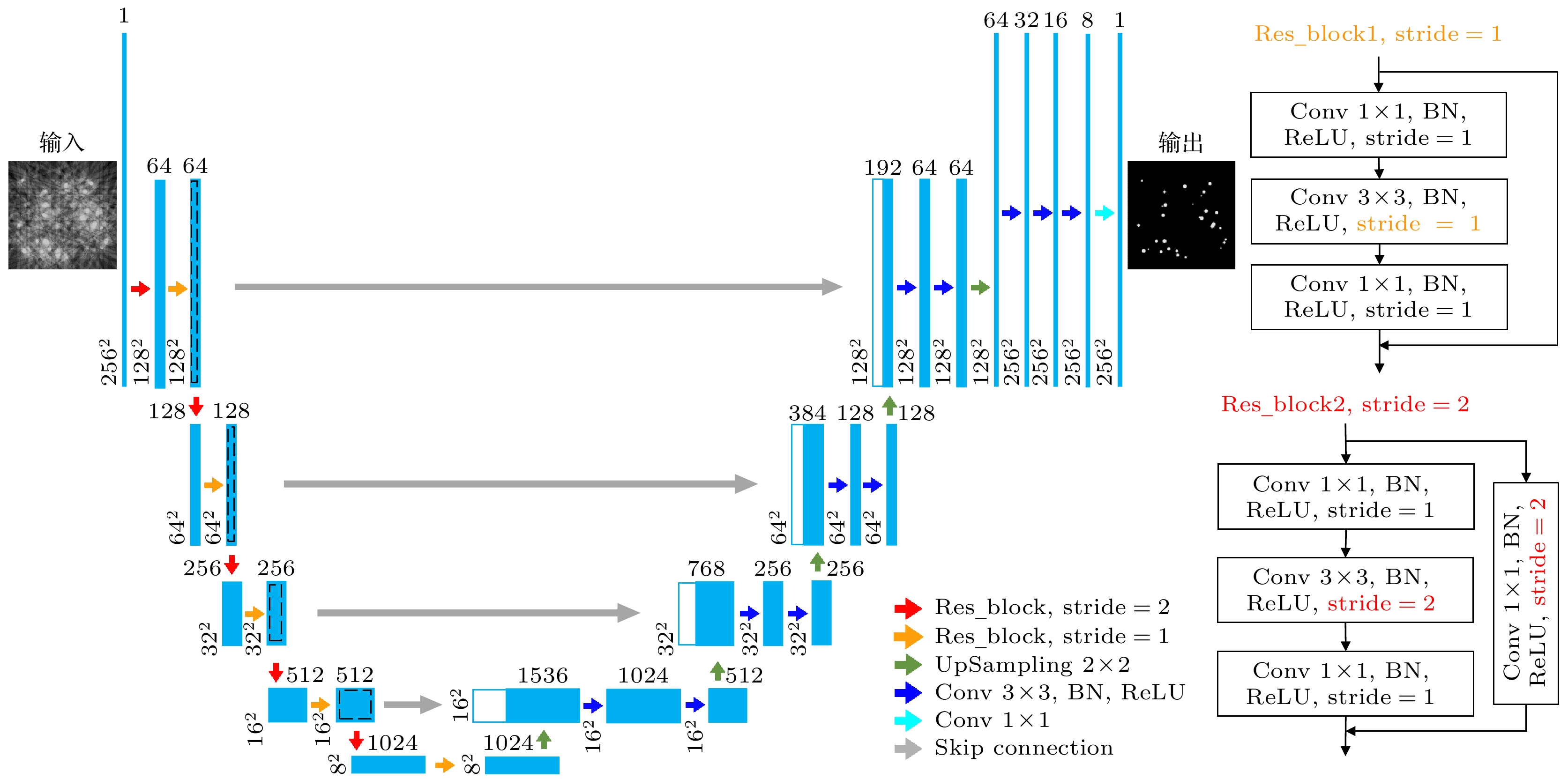
 下载:
下载:


